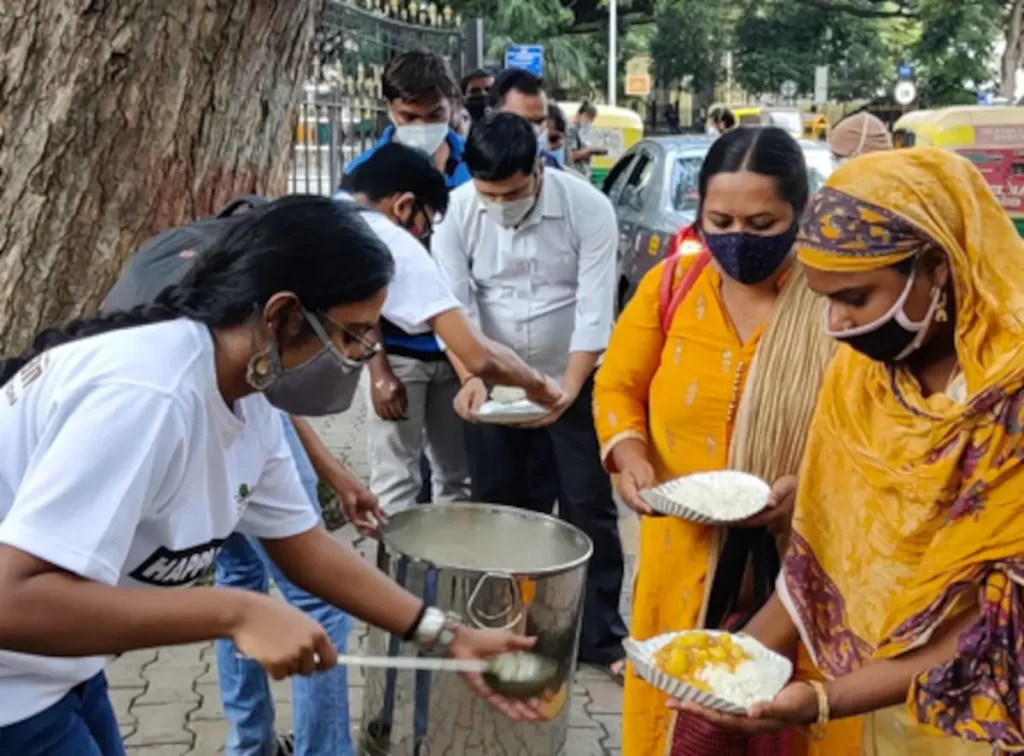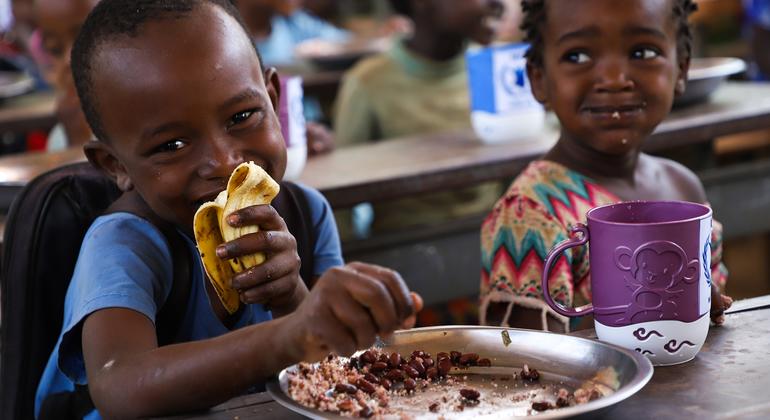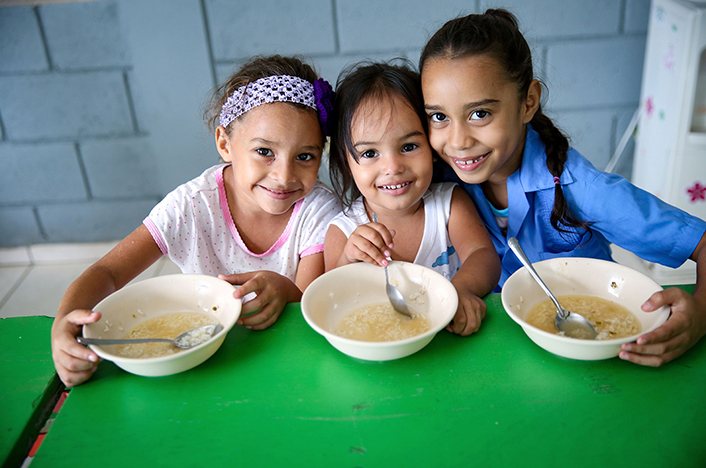The Power of a Meal: Combating Childhood Hunger One Plate at a Time
By providing nutritious meals to children in need, meal programs play a crucial role in ensuring their physical and cognitive development. Through collaboration and resource-sharing within the community, meal programs offer a sustainable solution to food insecurity among children. Beyond filling empty stomachs, these programs foster a sense of belonging, support, and dignity for vulnerable youth, empowering them to thrive. Through the simple act of sharing a meal, One Plate at a Time, communities can make a significant difference in the lives of children, laying the foundation for a brighter, healthier future for all.

The Impact of the ‘One Plate at a Time’ Approach on Childhood Hunger
The “one plate at a time” approach is immensely valuable in combating childhood hunger for several reasons. Firstly, it emphasizes the tangible impact of each meal on a child’s well-being. For children facing food insecurity, every plate of nutritious food represents not just sustenance but also the opportunity for physical and cognitive development. By focusing on providing meals one plate at a time, community meal programs ensure that no child goes hungry and that each child receives the nourishment they need to thrive.
Secondly, the “one plate at a time” approach allows for scalability and sustainability. Community meal programs often operate on limited resources, making it essential to prioritize and allocate resources effectively. By serving meals incrementally, these programs can reach a larger number of children over time, gradually expanding their reach and impact within the community. This incremental approach also fosters community engagement and support, as individuals and organizations can contribute in small but meaningful ways, whether through volunteering, donations, or advocacy.
Moreover, the “one plate at a time” approach promotes dignity and empowerment for children in need. Hunger can have profound physical, emotional, and psychological effects on children, affecting their self-esteem and sense of worth. By providing regular, nutritious meals, community meal programs affirm the inherent value and dignity of each child, empowering them to focus on learning, growing, and reaching their full potential. Additionally, these programs often offer a supportive environment where children feel welcomed, valued, and cared for, fostering a sense of belonging and community.
Overall, the “one plate at a time” approach is not just about feeding hungry children—it’s about providing hope, opportunity, and a brighter future. By recognizing the significance of each meal and the cumulative impact of consistent efforts, community meal programs play a vital role in combating childhood hunger and ensuring that every child has the chance to thrive.

how charity initiative can contribute in one plate at a time approach?
Charity initiatives are instrumental in supporting the “one plate at a time” approach to combat childhood hunger, offering a range of contributions that bolster community meal programs. Firstly, through food donations, charities provide essential supplies to these programs, ensuring they have the resources necessary to prepare nutritious meals for children in need. By offering a variety of food items, including grains, fruits, vegetables, and proteins, charities play a pivotal role in ensuring that meals are balanced and healthful, addressing not just hunger but also nutritional deficiencies that can affect children’s development.
Financial support from charity initiatives is equally vital, as it enables community meal programs to cover operational costs, purchase ingredients, and expand their reach. This funding ensures the sustainability of meal programs, allowing them to continue serving meals to children on a consistent basis. Additionally, charity initiatives often mobilize volunteers to support community meal programs through meal preparation, serving, and cleanup efforts. By donating their time and skills, volunteers directly contribute to the “one plate at a time” approach, assisting in the provision of meals and fostering a sense of community engagement and support.
Moreover, charity initiatives play a crucial role in advocacy and awareness-building around childhood hunger. By raising awareness about the issue and advocating for policies and programs that address food insecurity, charities create a supportive environment for community meal programs to thrive. Through education and outreach efforts, they highlight the importance of the “one plate at a time” approach and galvanize public support for initiatives aimed at combating childhood hunger.
Additionally, charity initiatives often form partnerships and collaborations with other organizations, businesses, and government agencies to maximize their impact. By leveraging resources, expertise, and networks, these partnerships enhance the effectiveness of efforts to address food insecurity and support community meal programs. Through collective action and collaboration, charities help ensure that every child has access to nutritious meals and the opportunity to thrive, embodying the spirit of the “one plate at a time” approach in their efforts to combat childhood hunger.
centralized and state-based assistance or decentralized and community-based initiatives
In terms of the one plate at a time, decentralized and community-based initiatives are often more effective in addressing childhood hunger. While centralized and state-based assistance programs certainly have their merits, community-based initiatives offer several advantages that align closely with the incremental and personalized approach implied by the one plate at a time.
Decentralized and community-based initiatives are inherently more agile and responsive to local needs and circumstances. They have a deeper understanding of the specific challenges faced by children and families within their communities and can tailor their efforts accordingly. By operating at the grassroots level, these initiatives can identify and address gaps in food access more effectively, ensuring that no child falls through the cracks.
Furthermore, community-based initiatives often foster a strong sense of ownership and accountability among participants. When community members are actively involved in the planning, implementation, and evaluation of programs, they are more invested in their success and sustainability. This sense of ownership encourages innovation, collaboration, and resourcefulness, leading to more creative and impactful solutions to childhood hunger.
Moreover, community-based initiatives are better positioned to leverage existing social networks, resources, and support systems within the community. They can tap into local partnerships, volunteers, and donations to maximize their impact, extending their reach and effectiveness. By fostering a culture of mutual aid and solidarity, these initiatives empower communities to take ownership of their own welfare and support one another in times of need.
Overall, while centralized and state-based assistance programs have a role to play in addressing childhood hunger, decentralized and community-based initiatives offer a more nuanced and personalized approach that is better aligned with the spirit of “one plate at a time.” By harnessing the collective efforts, resources, and ingenuity of communities, these initiatives can make a meaningful and sustainable difference in the lives of children facing hunger.
Decentralized Programs and one plate at a time
Decentralized programs contribute significantly to the “one plate at a time” approach by leveraging local resources, knowledge, and community networks to combat childhood hunger. Firstly, these programs offer tailored solutions that address the unique needs and challenges faced by children and families within their communities. Operating at the grassroots level, decentralized programs have a deep understanding of local contexts, allowing them to customize their efforts to ensure that each meal provided meets the immediate needs of children one plate at a time.
Moreover, decentralized programs exhibit flexibility and adaptability, crucial qualities in addressing childhood hunger effectively. Unlike centralized approaches, which may be constrained by bureaucratic processes and rigid guidelines, decentralized programs can quickly respond to changing circumstances and emerging needs. They have the agility to adjust their strategies, scale up or down, and reallocate resources as necessary to reach more children and provide them with the nourishment they need.
Additionally, decentralized programs foster community engagement and ownership, empowering local residents to take an active role in addressing childhood hunger. By involving community members in program planning, implementation, and evaluation, these programs cultivate a sense of ownership and accountability, ensuring that efforts to combat hunger are sustainable and responsive to local priorities. This grassroots engagement also builds trust and solidarity within the community, strengthening social cohesion and resilience.
Furthermore, decentralized programs capitalize on existing community networks and partnerships to maximize their impact. They leverage local resources, such as volunteers, donations, and infrastructure, to expand their reach and effectiveness. By collaborating with schools, churches, food banks, and other community organizations, decentralized programs create a network of support that extends beyond individual initiatives, creating a more comprehensive safety net for children experiencing hunger.
In conclusion, decentralized programs play a crucial role in the “one plate at a time” approach to combating childhood hunger. By harnessing local knowledge, resources, and community networks, these programs offer tailored solutions, flexibility, community engagement, and partnerships that contribute to the provision of nutritious meals for children in need, one plate at a time.

how community itself benefit from one plate at a time?
Communities reap numerous benefits from the “one plate at a time” approach to combating childhood hunger. Firstly, these efforts foster social cohesion by uniting community members around a shared cause. Collaborating to ensure that every child has access to nutritious meals strengthens bonds among residents, creating a tighter-knit community where individuals support one another. This sense of solidarity not only addresses hunger but also enhances overall community resilience and well-being.
Moreover, participating in community-based initiatives to provide meals one plate at a time empowers residents to take ownership of their collective welfare. By volunteering time, donating resources, or participating in program activities, community members gain a sense of agency and efficacy in making a positive impact on the lives of children in their neighborhood or town. This empowerment fosters a sense of purpose and fulfillment, as individuals recognize the tangible difference they can make in addressing a pressing social issue.
Furthermore, community-based efforts to combat childhood hunger contribute to the long-term resilience of communities. By building local networks, partnerships, and resources, communities become better equipped to respond to future challenges and crises. The infrastructure and relationships established through initiatives focused on providing meals for children create a foundation for collective action and support, strengthening the community’s ability to weather adversities and support vulnerable members, including children, in times of need.
Additionally, investing in children’s well-being through initiatives like the “one plate at a time” approach has positive ripple effects that extend far beyond immediate hunger relief. Ensuring that children have access to nutritious meals supports their physical, cognitive, and emotional development, laying the groundwork for a healthier, more prosperous community in the future. By prioritizing the needs of children today, communities are investing in a brighter tomorrow, where all residents have the opportunity to thrive.
In summary, the “one plate at a time” approach not only addresses the immediate issue of childhood hunger but also cultivates a sense of community, empowerment, resilience, and hope for the future. Through collective action and support, communities strengthen their social fabric and create a more inclusive and supportive environment for all residents, ensuring that every child has the opportunity to grow, learn, and succeed.
how people can start up community-based charity for children?
Starting a community-based charity for children begins with identifying the specific needs within your local area, whether it’s addressing food insecurity, education gaps, or lack of social support. Once the need is clear, establishing a mission and vision for the charity sets the foundation, outlining goals and values. Building a dedicated team of volunteers passionate about the cause is essential; they’ll help drive the organization’s efforts forward. Choosing a suitable legal structure and registering the charity ensures compliance with regulations and enables tax-exempt status for donations.
With a strategic plan in place, fundraising becomes crucial to sustain the charity’s operations and programs. Exploring various avenues such as individual donations, grants, and events helps gather the necessary financial resources. Developing tailored programs and services that directly address the identified needs of children in the community is key. This could range from providing meals and educational resources to offering mentorship or recreational activities.
Engaging the community through partnerships and awareness-building efforts amplifies the charity’s impact. Seeking input and feedback from stakeholders ensures programs remain responsive to local needs. Implementing and evaluating programs regularly helps monitor progress and measure impact effectively. Sustainability is achieved by diversifying funding sources, strengthening partnerships, and expanding reach over time.
Starting a community-based charity for children is a journey that requires dedication, collaboration, and adaptability. By mobilizing resources and rallying support from the community, you can make a meaningful difference in the lives of children and contribute to building a stronger, more compassionate society.
Final thought
In embracing the “one plate at a time” approach to combat childhood hunger, communities not only address an urgent social issue but also nurture a spirit of compassion, resilience, and unity. By coming together to ensure that every child has access to nutritious meals, communities strengthen their social fabric, empower individuals, and invest in a brighter future for all. Through collective action and support, communities embody the power of solidarity and demonstrate their unwavering commitment to the well-being of their youngest members. In the journey to alleviate childhood hunger, each plate served represents not just sustenance but also a symbol of hope, possibility, and community strength. Together, one plate at a time, communities forge a path towards a healthier, more inclusive, and thriving future for generations to come.
Read more: From Food Scarcity to Abundance: Transforming Lives Through Meal Programs


